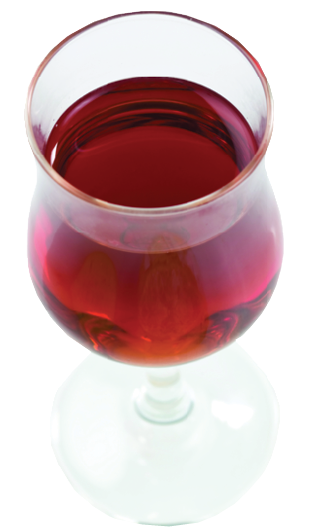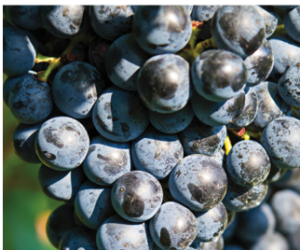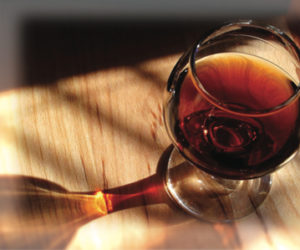 The word “fortified” is prohibited on commercial wine labels in the United States. Yet we are surrounded by a fascinating array of fortified wines when we visit a good wine shop. Fortified wines are simply those to which distilled spirits have been added to raise the final alcohol level. Some sweet dessert wines, like late harvest Zinfandel or Sauternes, may have elevated alcohol levels purely as a result of fermenting high-sugar musts. The world’s most famous sweet dessert wine, though, is Port. That wine, originating in Oporto in Portugal, is made with fortification — as are many “Port-style” wines from other countries. At the other end of the flavor spectrum from the sweet dessert wines, we find fortification in many aperitif wines — those traditionally served before a meal or with appetizers. Both dry (French) and sweet (Italian) vermouth are made by adding distilled spirits to a wine base.
The word “fortified” is prohibited on commercial wine labels in the United States. Yet we are surrounded by a fascinating array of fortified wines when we visit a good wine shop. Fortified wines are simply those to which distilled spirits have been added to raise the final alcohol level. Some sweet dessert wines, like late harvest Zinfandel or Sauternes, may have elevated alcohol levels purely as a result of fermenting high-sugar musts. The world’s most famous sweet dessert wine, though, is Port. That wine, originating in Oporto in Portugal, is made with fortification — as are many “Port-style” wines from other countries. At the other end of the flavor spectrum from the sweet dessert wines, we find fortification in many aperitif wines — those traditionally served before a meal or with appetizers. Both dry (French) and sweet (Italian) vermouth are made by adding distilled spirits to a wine base.
Beyond the U.S. label restriction, there are many rules, regulations, and taxes that address fortified wines. Commercial producers may typically use only distilled alcohol derived from the same product as the base wine — that is, grape wine distillate must be used to fortify grape wine. They cannot use, for instance, neutral grain spirits in a grape wine. Alcohol levels are also controlled, with many jurisdictions requiring at least 18% alcohol by volume (ABV), but no more than 24%.
Along with Port, the sweet fortified wines include Marsala, Madeira, Angelica, some Sherries, and a number of others. Among the fortified aperitif wines, vermouths are joined by such proprietary products as Dubonnet, originally formulated as a tonic for delivering a bit of quinine in a palatable form, along with drier versions of Sherry. Other beverages that may seem similar are not necessarily fortified wines. Campari, for instance, is prepared from distilled alcohol, water, herbs, and fruit. It is used as an aperitif, but is classified as a liqueur rather than a wine.
The fundamentals of making any fortified wine at home include all the basic home winemaking supplies plus well-matched distilled spirits. Although commercial fortified wines are often reported as being strengthened with “brandy,” it is not usually the kind of brown brandy or Cognac enjoyed as a beverage on its own. While brandy like that could be used for fortification, it would add color and oaky flavors that the winemaker may not want. Rather, the most common addition would more properly be called “grape spirits.” A distillate of wine, just like brandy, grape spirits differ in that they are not barrel aged and remain colorless, just as the distillate came from the still. Sometimes diluted with water to typical beverage spirit strength of about 80 proof (40% ABV), this product is also used at raw-still strength of about 190 proof (95% ABV). Using a higher concentration of added spirits allows for less dilution of the wine base and its corresponding flavor, color, and aroma. For home use, it can be challenging to find acceptable spirits. French Cognac company Remy Martin markets a grape distillate they call V, which is a colorless 80-proof grape spirit (at about $40 per 750 mL bottle at retail). Small-scale distiller Stillwater Spirits in Petaluma, California, has produced a product called Napa Vodka, also an 80-proof grape spirit. Alchemical Solutions of Ashland, Oregon produces pharmaceutical grade organic alcohols from grapes, cane sugar, wheat, and corn. At 190 proof, the grape alcohol sells for about $160 per gallon. Consider the more widely available grain-neutral spirits if you cannot find grape alcohol. Brands like Everclear, Diesel, and Clear Springs are bottled and sold at 190 proof where state laws allow, or at 151 to 153 proof in more restrictive states. Cost is around $20 per 750-mL bottle.
Once you have your wine source in mind and you have identified a distilled spirit for fortification, you need to choose your target alcohol level. Various fortified wines generally fall between about 18% and 24% ABV. To make your fortification calculation, you also need to know (or estimate) the alcohol level of your base wine. If you have your own ebulliometer, analytical distillation apparatus, or access to a wine lab, you can test the alcohol level. Otherwise, a pretty good estimate can be achieved by multiplying °Brix consumed in fermentation times 0.55. For example, a must that started at 23 °Brix and finished dry would represent 23 °Brix consumed. 23 x 0.55 = 12.65% ABV. A number like that is sufficiently accurate for use in calculating your spirit addition using Pearson’s Square.
This handy calculation tool can be depicted as a square grid with five variables, A through E:
A D
C
B E
For calculating the spirit addition to a base wine, the following factors are applied:
A = ABV, distilled spirit
B = ABV, base wine
C = target ABV for fortified wine
D = C – B, parts spirit
E = A – C, parts wine
Since we will be applying Pearson’s Square for the wine projects presented below, we will first review a generic example. Suppose you have a base wine of 12% ABV and you want to fortify it to 18% ABV. You will use grain spirits of 151 proof (75.5% ABV).
A = 75.5
B = 12
C = 18
D = 18 – 12 = 6 parts spirit
E = 75.5 – 18 = 57.5 parts wine
Now comes what may be the trickiest part — translating “parts” into actual volumes. First look at total “parts” calculated: 6 + 57.5 = 63.5 parts total. Then look at the total volume of your intended final batch, in units that make for convenient calculations — often ounces. For instance, if this is a project to produce a finished 5 gallons (19 L) of fortified wine, the final content will contain 640 ounces. With a total of 640 ounces corresponding with a total of 63.5 “parts,” we can see that there will be 640/63.5 or 10.1 ounces per part in the final blend. For the spirits, then, we have: 6 parts x 10.1 oz. per part = 60.6 oz. (a bit under a half gallon or two liters). For the wine, we have: 57.5 x 10.1 = 580.8 oz. Combining 580.8 oz. of wine (18.15 qts/17 L) with 60.6 oz. (1.9 qts/1.8 L) of 151 proof spirit will produce 5 gallons (19 L) of 18% ABV fortified wine.
With that generic application of Pearson’s Square in hand, let’s review some of the world’s fortified wine traditions and how they can be emulated at home. The Port wine tradition originated in trade between Portugal and England. When producers of red wine in Portugal’s Douro Valley learned that English importers were sweetening and fortifying the wine for English consumers, they developed methods for doing the preparation themselves. While there are numerous categories for Ports and Port-style wines (those not made in Portugal), the methods are basically the same. Red wine grapes are crushed and fermentation commences. At a hydrometer reading of about 6 °Brix (representing about 10% residual sugar), distilled grape spirits are added to stop the fermentation. Barrel aging and bottling techniques are similar to those for dry red wines.
To make a Port-style wine at home, you may start with an ingredient kit, red grape concentrate, or fresh or frozen red wine grapes. If using a kit or concentrate, you will usually rely on a high sugar level or chaptalization to achieve typical Port wine strength of 18 to 20% ABV. From grapes, the addition of spirits is more directly in the Portuguese tradition. Here is a plan I followed in making 5 gallons (19 L) of Port-style wine from locally grown Syrah grapes.
I used 125 lbs. (57 kg), intending to start with about 6 gallons (23 L) of wine to allow for racking a few times and finishing with 5 gallons (19 L). Add sulfites, about 50 ppm. Cold soak if you like (I did not do that), and add yeast. It is a good idea to select a strain that is less aggressive — especially one that is known to stop with cold temperature (more on that, below). For my Port-style wine, I chose Epernay II (brand name Uvaferm CEG). Nutrients are not generally needed for the short fermentation of a Port-style wine and I did not use any. However, my wine did develop a sulfide stink that I later needed to remove with copper sulfate, so I might reconsider the “no nutrients” decision when I do this again.
Punch down two or three times per day, just as for any red wine. As noted above, Port is usually stopped at about 6 °Brix. Since I expected that fermentation might go on through the pressing and stopping stages, I let the must drop to 10 °Brix and began the stopping process. My grapes had started at 26.2 °Brix, so 26.2 – 10 = 16.2 °Brix consumed and 16.2 x 0.55 = 8.9% estimated ABV. I used 151 proof (75.5% ABV) Everclear grain neutral spirits to fortify. I decided to use a target finished alcohol level of 19%.
For Pearson’s Square, then,
A = 75.5
B = 8.9
C = 19
C – B = 10.1 parts spirit
A – C = 56.5 parts wine
This is a total of 10.1 + 56.5 = 66.6 parts. We want to plan for a volume of 5 gallons (19 L) at this stage, so that is 640 ounces and 640/66.6 = 9.6 oz./part. I needed 10.1 x 9.6 = 97 oz. of spirits and 56.5 x 9.6 = 542 oz. of wine.
Chilling is a good way to stop the fermentation. If you can chill in a refrigerator, you may use any carboy. For chilling with ice, a stainless steel soda syrup keg or a PET plastic carboy is safer. For my project, I pressed the fermenting must and funneled the new wine into a 5-gallon (19-L) stainless steel keg, adding 50 ppm of sulfite. I put the keg in a 20-gallon (76-L) plastic fermenter and filled with ice around the keg. The yeast dropped out and after 48 hours I racked fairly clear ruby-colored wine into a 5-gallon (19-L) carboy, in which I had placed the 3 quarts of spirit. Another 50 ppm of sulfite went in as well. Fitted with a fermentation lock and kept cool, the wine continued to ferment slowly for three more days, then stopped entirely. I aged it for 10 months, racking twice, sulfiting regularly, and adding one dark French oak stick to the carboy. I bottled my Port-style wine in 375 mL bottles and it has been providing an enjoyable finish for dinners with friends for several years now.
Sherry, the famous fortified wine of Spain, undergoes two fortification steps. Finished white wine is first fortified to about 15.5% ABV, a strength that inhibits spoilage bacteria but encourages the growth of aerobic “flor” yeast on the surface of the wine. Wine is aged in a special stack of barrels called a “solera.” The oldest wine is removed from the bottom row for finishing and wine is racked progressively downward, making room for new wine to be added at the top. The barrels are left about 3⁄4 full, allowing air to encourage the growth of the flor yeast, a surface film yeast that takes its name from the flower-like appearance of its growth. It is this secondary flor fermentation and corresponding slow oxidation that imparts the unique nutty, raisiny flavors and aromas to Sherry. After wine is removed from the last row of the solera, it is fortified again, this time to 18–20% ABV. Some Sherries are not put through the flor process, relying on conventional oxidation instead.
I have not tried making a Sherry-style wine at home, but if you would like to try it, Philip Jackisch provides a detailed example for a 5-gallon (19-L) solera made up of five 1-gallon (3.8-L) jugs in his book Modern Winemaking. His method can produce about two gallons (7.6 L) per year and can be maintained indefinitely with new wine additions.
Vermouth is commonly made in two distinct styles. Dry (French) vermouth is clear and colorless to pale straw or pale green. Sweet (Italian) vermouth is brown or amber. Both are based on white wine, infused with herbs, and fortified with grape spirits. Caramel color is added to sweet vermouth, which is always sweetened.
For my aperitif project, I made a dry vermouth. Many different herbs, roots, and seeds may be used for vermouth production; Jackish lists 39 of them. Most are applied at levels of one to six grams per gallon of finished product. A good way to add the botanicals is to first extract them in the spirit that will be used for fortification. To do that, we need to determine how much spirit will be required. Desiring an aromatic base for my vermouth, I chose a 2012 homemade Viognier that came in at 12% ABV. I wanted to make one gallon of vermouth at 18% ABV and I used Diesel neutral spirits at 153 proof (76.5% ABV) for fortification.
This yields:
D = 18 – 12 = 6 parts spirit
E = 76.5 – 18 = 58.5 parts wine
58.5 + 6 = 64.5 parts total.
For one gallon/3.8 L (128 ounces), we get 128/64.5 = 1.98 oz. per part (two ounces is close enough for practical concerns). So I needed 2 x 6 = 12 oz. of Diesel and 2 x 58.5 = 117 oz. of wine. To allow for a small loss of spirits when I ran the infusion through a paper coffee filter, I started with 14 oz. of spirits in a one-pint mason jar. I lightly cracked the seeds in a mortar and pestle and added the following to
the jar: 0.2 oz. (6 g) dried bitter orange peel, 0.07 oz. (2 g) dried mugwort, 0.07 oz. (2 g) cardamom pods, 0.14 oz. (4 g) coriander seeds, 0.07 oz. (2 g) dried juniper berries, 1 dried star anise (about 0.02 oz./0.6 g), and 1 three-inch sprig fresh rosemary. Many of these herbs and spices are available at homebrew supply stores as they are used in brewing various spiced ales. Others can be found at specialty spice shops or at the supermarket.
The infusion quickly took on an attractive light-green color and exhibited a bright, herbaceous aroma. After leaving the infusion in a dark cupboard for a week, swirling it a few times each day, I strained it through a coffee filter to remove the spent herbs. Measuring 12 ounces into a 1-gallon (3.8-L) jug, I filled to the bottom of the neck with Viognier. I am letting the finished product rest for a month and will fine it with bentonite or Sparkolloid if it does not drop completely clear on its own. I plan to bottle this in 375-mL bottles and share them among my friends.






